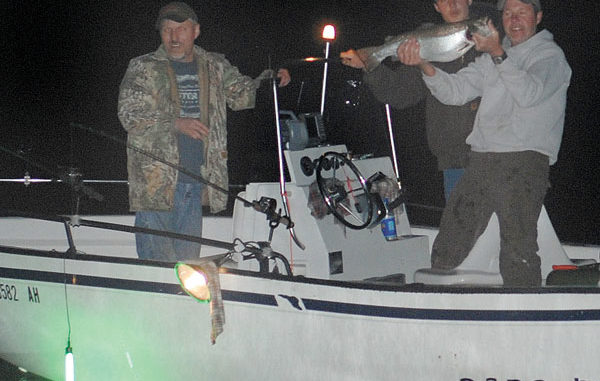
Lake Jocassee’s trout fishery is great, especially after dark
During the early 1970s, while actors Burt Reynolds, Jon Voight and Ned Beatty were paddling around the Jocassee and Tallulah gorges filming Deliverance, a 13-year-old outdoorsman by the name of James Couch was busily fishing the nearby Whitewater, Horsepasture, and Thompson Rivers.
Mirroring the movie’s plot, Couch’s wild rivers were soon covered by a large reservoir — Lake Jocassee, a 7,500-acre, 300-foot deep project created by Duke Power. He quickly adapted to fishing the deep, clear reservoir and has over the years caught two state-record fish from the lake, a spotted bass and a redeye bass.
Couch grew up and remained in the area, becoming a fishing guide on Jocassee. He said he’s been fishing the lake longer than any other guide and he has seen much, including the creation of a put-grow-and-take trophy fishery for rainbow and brown trout.
When Jocassee was being impounded, biologists with the state agency weren’t exactly certain that an impoundment fishery for trout was viable. Trout need cold water and high dissolved-oxygen levels to survive, and they questioned whether the lake, while incredibly deep by South Carolina standards, could provide everything trout needed to survive.
It was understood from the beginning that trout probably would not be able to spawn due to the reduced amount of flowing water required to trigger spawning. That problem was solved by annual stockings of brown and rainbow trout from the nearby Walhalla fish hatchery, then federally-owned and the source of brood stock for streams in the Appalachian mountains.
In 1972, 10,000 brown and rainbow trout — nine inches long — were stocked into Jocassee. In a gesture of good faith, 34,000 threadfin shad were also planted in hopes that the trout would learn to survive on the baitfish instead of their normal diet of insects and crayfish.
The state records at the time were 5 pounds, 8 ounces (rainbow) and 13 pounds, 1 ounce (brown). In 1987, Larry Edwards of Pickens caught the current state-record brown, a 17-pound, 9½-ounce behemoth, and in 1993, Scott Coggins of Traveler’s Rest reset the current rainbow record at 11 pounds, 5 ounces. Both fish came from Lake Jocassee.
Reports of monster trout and broken records were abundant throughout the late 1980s and early 1990s. Some fishermen are afraid the trend is starting to wane, as evidenced by a recent proposal to reduce the daily creel limit. While deep-water trolling for trout on Jocassee is a complex issue, fishing for them at night isn’t all that different from night fishing for any other species.
“The best night-fishing for trout on Jocassee occurs during April, May and June,” said Couch (864-982-1016). “Two factors occur at the same time to make the fishing so good. One is that baitfish are spawning on the rocks at Keowee during the late spring. The second is that pump-back activity, usually occurring at night, sucks water and baitfish from Keowee into Jocassee at the intakes. The moving water and injured baitfish is like ringing the dinner bell for the trout.”
The 4-unit Jocassee Hydroelectric Station is a 610-megawatt, pumped-storage generating facility. The facility works much like a conventional hydroelectric station, except that it can reverse turbines and pump previously used water from Lake Keowee to Jocassee to store potential energy for later. The Jocassee facility typically generates power during times of peak electric demand. After the terrorist attacks on Sept. 11, 2001, boating access to the waters near the station has been restricted. At sunset on Jocassee during, several boats can often be found moored end-to-end along the edge of the barrier that restricts boating access. Couch’s 32-foot pontoon boat is frequently in that line-up.
“If it’s a night with no wind, I’ll tie up to the PVC pipe barrier, but weather on Jocassee, especially during the spring, can change quickly,” he said. “If the wind is coming down the lake, I’d rather tie up to the shoreline near the intakes and back out into the lake and drop anchor.”
Couch recommends fishermen arriving for after-dark activity come equipped with at least 450 feet of anchor line to make sure they have enough rope to get a good anchor. Once anchored, Couch fires up two gas-powered generators and runs four sodium-vapor lights to attract baitfish. The generators’ noise can be loud, but Couch believes the noise and vibration mimic the churning water from the intakes. In fact, once he’s set up just before dark, it’s not unusual for his party to be well on their way to a 5-fish limit before the pump-back starts.
“I’ll put out six lines and bait each one with live minnows, frozen cut herring, or whole nightcrawlers,” he said. “Trout are not particularly line-shy at night, so I fish light to medium tackle with 10-pound test (line). The bait is hooked on a 1/0 Eagle Claw gold Aberdeen hook. The amount of weight used depends on when and how much current is being generated. I begin with a half-ounce before the pumping starts and then change over to a 1-ounce egg sinker.’
Duke Power is in the middle of a major upgrade to the Jocassee hydro station this spring, which includes replacement of the four turbines used for the pump-back. According to Erin Culbert, a company spokeswoman, pumping has been occurring during the upgrade, but at a reduced rate.
“During the outage for Jocassee upgrades, Duke Energy has been able to pump back from Lake Keowee to Lake Jocassee via one unit at Jocassee Hydro,” she said. “This practice will continue through the spring on a regular basis. There are many variables involved in the pumping schedule, but generally you will continue to see pumping for five to six hours a day. There will be days, however, with no pumping and others with longer pumping. As you know, pumping occurs during off-peak times, so you’d be likely to see pumping starting somewhere between 11 p.m. and 1 a.m. and ending in early morning from 5 a.m. to 7 a.m. Once Units 1 and 2 are returned to service, we’ll be able to return to pumping with all four units.”
With moving water and plenty of light generated to draw baitfish, Couch spends most of his time fishing for bait while his clients fish for trout. Rainbows readily take whole nightcrawlers, and Couch said he catches more than 50 percent of his rainbows on them. The big browns, however, much prefer fresh fish.
“The frozen herring will work until it thaws out, then it won’t stay on the hook,” he said. “Hopefully by then, I’ll have been able to catch some herring by either snag-hooking them or catching them on a Sabiki rig. My brown catches are about 50-50 between fresh cut herring and whole live herring.”
Cast nets are prohibited on Jocassee; you can’t even have one in the boat. Many fishermen “fish” for bait by jigging a Sabiki rig with tiny gold hooks or by snagging baitfish as they congregate under the lights. Blueback herring, which were supplementally stocked at Jocassee to compliment the shad, are the primary catch.
“Trout will hold at specific depths under the baitfish, so it’s important to keep watch on your graph,” said Couch. “My clients who meticulously count down to the depths where I tell them I’m seeing trout on the graph are the one’s who consistently catch fish.”

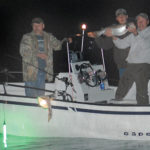
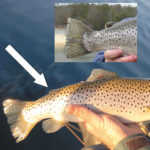
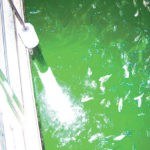
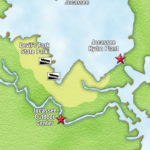
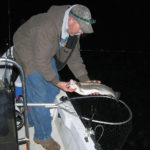
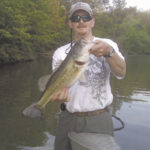

Be the first to comment